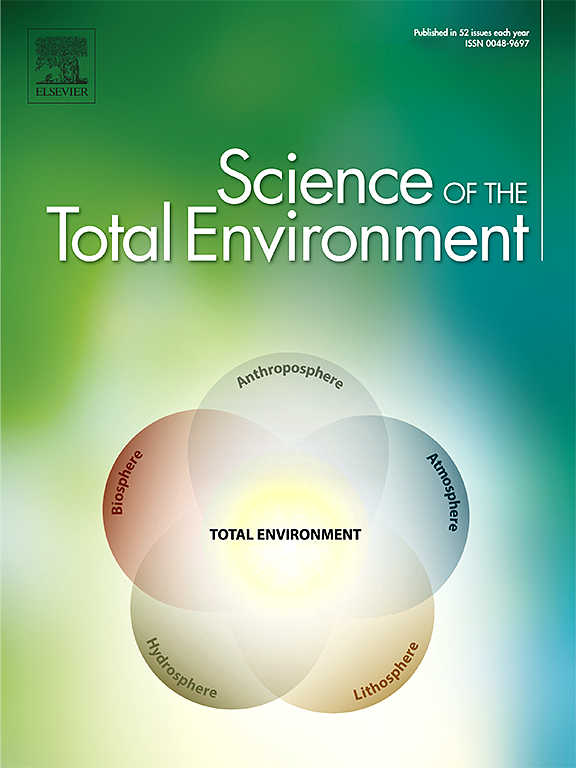Molecular foundations for shear-induced dynamics of natural organic matter
IF 8.2
1区 环境科学与生态学
Q1 ENVIRONMENTAL SCIENCES
引用次数: 0
Abstract
The overall objective of the present work was to quantify how shear, coupled with varying salt concentration, affected the particle size distribution and relaxation/aggregation behavior for various organic sources of nonliving natural organic matter (NNOM) in surface water. NNOM has been implicated as a conditioning agent leading to the formation of biofilms such as algae. NNOM is also a responsible in surface waters for facilitated transport of a variety of anthropogenic pollutants. These are NNOM surface-related phenomena, yet the variable surface area and surface composition of NNOM, which can change dependent on shear rate, is not discussed in the literature. NNOM polymer-like dynamics can interact with stream water velocity differences to determine the process and result of aggregation. The fundamental role of post-shear NNOM molecular structure and dynamic aggregation (self-assembly) is examined here alongside fresh (hydrological) versus mined (terrestrial) NNOM. Shear rate can be seen as a change in the velocities of streamlines in hydrology. In this early work, the response to shear rate for three types of NNOM was measured using a stress-controlled rheometer under varying conditions of ionic strength. Samples were studied for rheological response after a variety of pre-shear conditions, and data then coupled with surface composition data from previously reported fluorescence studies. Interestingly, a size class of 5 μm aggregates disappeared when Aldrich humic acid samples were treated with 0.3 M Ca2+. Evidence is also presented that the environmental samples flocculated at shear rates up to 400 s−1, rather than exhibiting particle breakup, with implications for reducing NNOM surface area. Dynamic response of different NNOM sources was not the same, some sources showing evidence of self-assembly. The molecular response to shear may play an important role in understanding the surface area and composition of NNOM responsible for facilitated transport of pollutants and initiation of biofilms.

天然有机物质剪切动力学的分子基础。
本工作的总体目标是量化剪切与不同盐浓度如何影响地表水中不同有机来源的无生命天然有机质(NNOM)的粒径分布和弛豫/聚集行为。NNOM被认为是一种调节剂,导致生物膜的形成,如藻类。NNOM还在地表水中促进各种人为污染物的运输。这些都是与NNOM表面相关的现象,但NNOM的可变表面积和表面组成,可以依赖于剪切速率的变化,在文献中没有讨论。NNOM类聚合物动力学可以与水流速度差相互作用,从而决定聚集的过程和结果。剪切后NNOM分子结构和动态聚集(自组装)的基本作用将在这里与新鲜(水文)与开采(陆地)NNOM一起进行研究。剪切速率可以看作是水文学中流线速度的变化。在这项早期工作中,使用应力控制流变仪在不同的离子强度条件下测量了三种NNOM对剪切速率的响应。研究了样品在各种预剪切条件下的流变响应,然后将数据与先前报道的荧光研究的表面成分数据相结合。有趣的是,当Aldrich腐殖酸样品被0.3 M Ca2+处理时,5 μm聚集体的大小类别消失了。也有证据表明,环境样品在高达400 s-1的剪切速率下絮凝,而不是表现出颗粒破碎,这意味着减少NNOM表面积。不同NNOM源的动态响应不尽相同,有些源表现出自组装的迹象。分子对剪切的响应可能在理解NNOM的表面积和组成方面发挥重要作用,NNOM负责促进污染物的运输和生物膜的形成。
本文章由计算机程序翻译,如有差异,请以英文原文为准。
求助全文
约1分钟内获得全文
求助全文
来源期刊

Science of the Total Environment
环境科学-环境科学
CiteScore
17.60
自引率
10.20%
发文量
8726
审稿时长
2.4 months
期刊介绍:
The Science of the Total Environment is an international journal dedicated to scientific research on the environment and its interaction with humanity. It covers a wide range of disciplines and seeks to publish innovative, hypothesis-driven, and impactful research that explores the entire environment, including the atmosphere, lithosphere, hydrosphere, biosphere, and anthroposphere.
The journal's updated Aims & Scope emphasizes the importance of interdisciplinary environmental research with broad impact. Priority is given to studies that advance fundamental understanding and explore the interconnectedness of multiple environmental spheres. Field studies are preferred, while laboratory experiments must demonstrate significant methodological advancements or mechanistic insights with direct relevance to the environment.
 求助内容:
求助内容: 应助结果提醒方式:
应助结果提醒方式:


